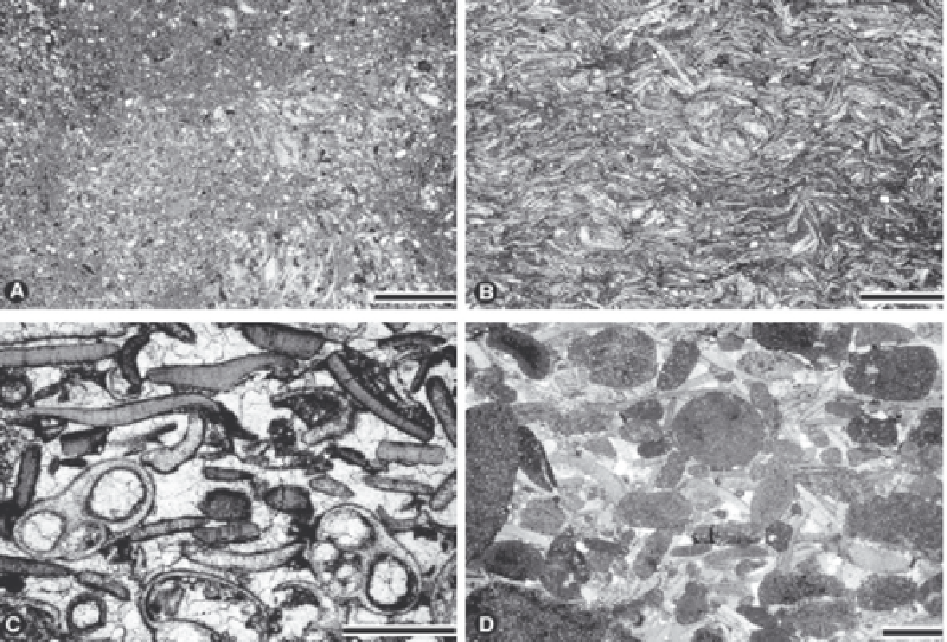Geology Reference
In-Depth Information
Fig. 15.9.
Lacustrine microfacies types
from the Early Devonian Old Red Sandstone (Woodbay Formation) in central North
Spitsbergen.
A:
Strongly bioturbated mudstone-wackestone (LMF 1). Sand-sized quartz grains and various skeletal grains
(ostracods, charophycean oogonia, fish fragments) are embedded within a micritic matrix.
B:
Bioclastic ostracod packstone
(LMF 6). Densely packed, thin ostracod valves forming a coquina. The accumulation is interpreted as population spread
under favorable conditions.
C:
Bioclastic gastropod grainstone (LMF 8). The gastropods are associated with thick-shelled
ostracods. Littoral lake environment.
D:
Lithoclastic rudstone (LMF 13). Most grains are very well rounded. The granule- to
pebble-sized mudstone clasts were accumulated by storms. Scale is 1 cm. After Blomeier et al. (2003).
tribute to carbonate formation and destruction. Carbon-
ate formation in lakes
by algae and cyanobacteria is
triggered by
the trapping and binding of particles, ce-
mentation by and encrustation with CaCO
3
, and secre-
tion of CaCO
3
within algal mucus. Cyanobacteria and
algae assist in the growth of oncoids, stromatolites and
reefs. In addition, accumulations of benthic and plank-
tonic algae as well as invertebrate shells contribute to
the formation of lacustrine carbonates. Destruction of
carbonates occurs by means of endolithic algae and bac-
teria loosening carbonate surfaces and producing fine-
grained sediment.
fossils. In addition, accumulations of lithoclasts and
intraclasts may be common. Fossils include cyanobac-
teria, algae, gastropods and bivalves, ostracods, fish
bones, scales and teeth, and amphibian remains. Algae
are represented by green algae (Cladophorales) and
occasionally also by calcareous algae known predomi-
nantly from marine environments (Pl. 131/4). Saltwa-
ter lake carbonates are poor in fossils but may yield
ostracods and some remains of crabs. Other common
criteria include stromatolites, oncoids and ooids (Pl.
13/1). Common fabrics of lacustrine carbonates are
lamination and varves, nodular structures and biotur-
bation.
15.4.1 Microfacies of Lacustrine Carbonates
Stromatolites
Cyanobacteria contributing to the formation of stro-
matolites are strongly salinity-controlled. Stromatolites
originate in marine and marginal-marine environments
of normal and hypersaline salinities as well as in non-
marine environments including freshwater and brack-
ish lakes, and salt and soda lakes (Riding 2000).
15.4.1.1 Microfacies Criteria
Common microfacies criteria of freshwater lake car-
bonates are micrite, peloids, radial ooids (see Boxes
4.15 and 4.16), oncoids and stromatolites, and various

